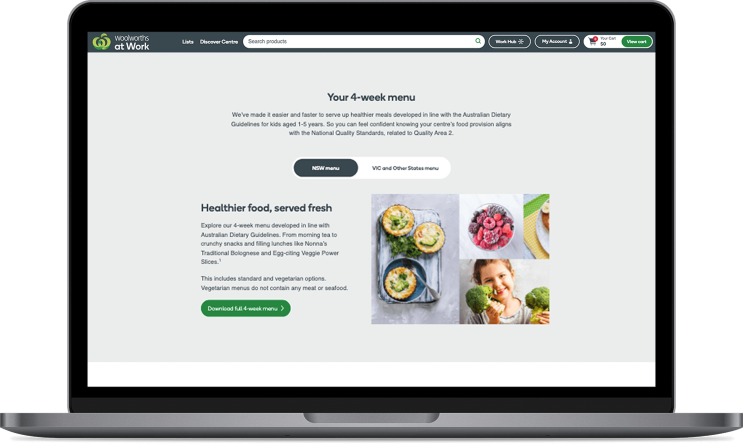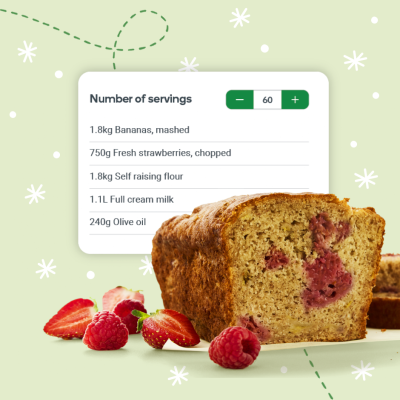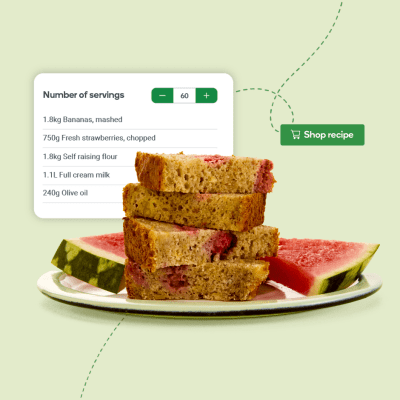Fireside chat with Brady Dennett and Anneliese Twigg
Early Learning Centres are often juggling multiple sites with children of all ages, needs, tastes and preferences. Staff can at times need to multi-task with time in the kitchen, time in the classroom and also work on back office administration.
Meal planning has become more complex with more interest from parents and regulatory focus on food. There is also much research on the impact food can have on behaviour and long-term health if the right behaviours are not embedded early, so many ELCs are wanting to make a long-term positive impact on the children in their care.
With so much to juggle and balance, what can be done to make the time-consuming and complex task of Meal Planning and Preparation easy?
Brady Dennett, Head of Marketing, Woolworths at Work sat down with Anneliese Twigg, Head Nutritionist at Nutrition Australia to talk about all things Meal Planning for children.
Can you tell me a little bit about Nutrition Australia?
“We are Australia’s leading nutrition non-profit organisation, providing credible, independent and practical information, education and business-to-business (B2B) consultation and advisory services to help create a healthier future for all Australians.
Our experienced nutritionists and dietitians collaborate with health organisations, governments, universities and other key organisations to influence public health nutrition policy and make healthy eating the ‘norm’ in our community. Nutrition Australia (Vic Division) has two units – The Healthy Eating Advisory Service (HEAS) and the Nutrition Programs & Services (NPS) unit.
What kind of services do you offer?
“HEAS supports organisations, including early childhood services, schools, outside school hours care programs, hospitals and health services, sport and recreation facilities and universities to implement the Victorian Government’s healthy eating policies and guidelines to create an organisational culture of healthy eating.
HEAS also work with the food industry to make it easier for them to provide healthier foods and drinks. The NPS team partners with a wide range of organisations including government departments, universities, workplaces, education settings and food industry to deliver a wide range of projects and services. This includes menu assessments, product classifications, workplace wellbeing programs, education sessions, content creation and nutrition communications, insights sessions and more! You can find out more about Nutrition Australia and our services on our website: https://nutritionaustralia.org/
What needs to be considered when developing a menu for children?
“When children eat nourishing food they are more alert, find it easier to learn and more likely to develop to their full potential. Developing a menu that offers healthy foods and drinks is a part of helping kids develop a love for nourishing food. Each state and territory has their own menu planning guidelines that will help services provide menus that meet the nutrition needs of children. But some simple things to start with to consider are to be sure to offer a variety of fruit and vegetables every day, don’t include discretionary food and drinks on the menu and make sure water is freely available through out the day and written on the menu. Small changes can make a big difference!
Also remember that promoting healthy eating in your centre is everyone’s responsibility and should include management, chefs/cooks, educators, children and families. The Healthy Eating Advisory Service have a number of resources available to help make menu planning easier: https://heas.health.vic.gov.au/early-childhood-services

You have created a 4-week menu plan with 60 recipes exclusively for Woolworths at Work customers – what can customers expect?
“The menus have been developed to be in line with the Australian Dietary Guidelines for children aged 1-5 and to help centres meet the menu planning guidelines for each state and territory and in turn meet children’s nutrition needs. So you can be assured that by following the menus you’ll be giving the children at your centre everything they need to thrive!
There are 4 weeks of menus plus a vegetarian menu option that all include morning tea, lunch and afternoon tea, plus some general advice on what can be offered for breakfast or a late snack. You’ll receive the menus plus full recipes. There is plenty of variety, including different cuisines and healthy spins on old favourites, like burgers and fried rice, plus creative ways to make mealtime fun, for example – ‘Build your own lettuce boat’ for San Choy Bau.
Free Seasonal Meal Plans from Nutrition Australia
- Choose from the 4-week menu plan with 60 recipes designed by Nutrition Australia exclusively for Woolworths at Work customers
- Save time and costs by removing time spent on planning
- Free up resources to focus on other important things in your centre
- Provide healthy and nutritious options giving parents peace of mind
- Four week menu including standard and vegetarian options
- NSW, VIC and other States
- Access in the Discover Centre – full of resources to make things easy
Any tips for fussy eaters?
“While it can be challenging, food refusal and picky eating is normal in children and there is a lot you can do to create positive meal time environments and make children feel comfortable accepting and trying new foods. Again, everyone in the centre can play a role from management implementing guidelines and policies to cooks and educators. Our top tips are to:
- Create a positive mealtime environment by ensuring meal times are the same each day for structure and routine, reducing distractions at meal times and using positive language that isn’t forceful. So instead of ‘Come on just take one bite’, turn it into a fun positive conversation such as ‘I wonder what this carrot tastes like? Is it sweet? Is it crunchy? Let’s see!”
- Role model healthy eating and trying new foods yourselves in front of the children, and
- Repeated exposure – it can take 20 exposure or more before a child decides to try a food, so increase exposure by including the same foods in different ways on the menu, include food in play, activities and story time and as part of the curriculum. You could even try starting your own veggies garden to get kids curious about how their food grows
We recently partnered with Woolworths at Work, to deliver an virtual event on this topic. It was a 60 minute Q&A on strategies for reducing food refusal, a topic we wanted to explore due to ongoing interest from the Early Learning sector. The interactive webinar explored how to empower your organisation through policy, in order to overcome the common issues of fussy eating, food refusal and reducing food waste for the Early Learning Centres.



